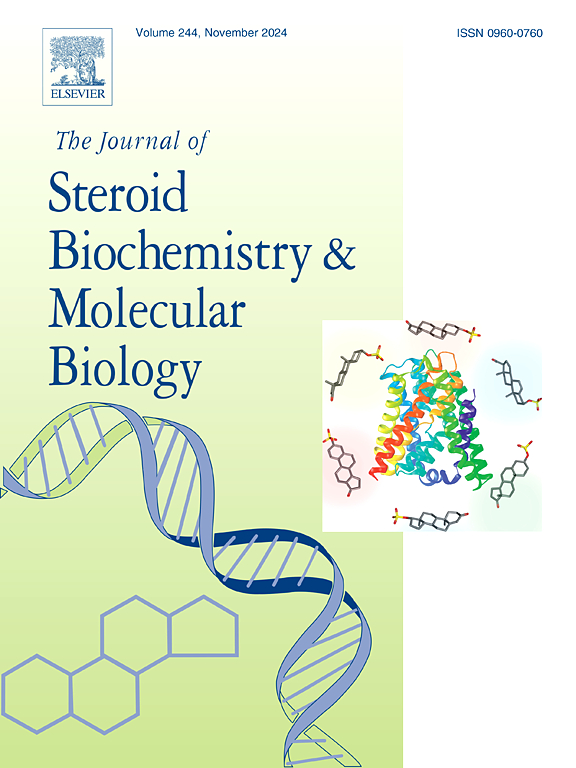结合雌二醇、二氢睾酮和睾酮的性激素结合球蛋白单体的典型构象的量子生物化学表征
IF 2.5
2区 生物学
Q3 BIOCHEMISTRY & MOLECULAR BIOLOGY
Journal of Steroid Biochemistry and Molecular Biology
Pub Date : 2025-10-01
DOI:10.1016/j.jsbmb.2025.106873
引用次数: 0
摘要
性类固醇激素在血浆中的转运主要由性激素结合球蛋白(SHBG)介导。SHBG是一种功能性同型二聚体,这意味着它可以结合两种具有相似亲和力的性激素。这种结合通过复杂的变构机制发生。这种球蛋白在调节目标组织和细胞内性激素的可用性方面起着关键作用。鉴于SHBG与各种病理疾病之间的相关性,人们对表征SHBG与激素之间的相互作用以及确定SHBG功能的潜在抑制剂或调节剂的兴趣越来越大。在这方面,本研究旨在为SHBG与雌二醇(EST)、二氢睾酮(DHT)和睾酮(TES)的结合提供新的见解。为此,本文运用了分子对接、分子动力学和量子力学等方法。对最高和最低相互作用能的代表性构象的分析表明,它们的结合位点高度相似。SHBG::TES相互作用与SHBG::EST和SHBG::DHT复合物表现出高度的结构和能量相似性,但缺乏结构数据。量子力学计算表明,理论结合亲合力由高到低依次为:SHBG::DHT >; SHBG::EST >; SHBG::TES。此外,SER42、PHE67、MET107和MET139表现出最低的相互作用能,从而强调了这些残基在SHBG偶联和类固醇激素运输中的关键作用。这些复合物的能量描述有助于更深入地了解类固醇激素的转运,并为靶向SHBG的药物发现提供新的见解。本文章由计算机程序翻译,如有差异,请以英文原文为准。
Quantum biochemistry characterization of representative conformations of the sex hormone-binding globulin monomer bound to estradiol, dihydrotestosterone and testosterone
The transport of sex steroid hormones in the plasma is largely mediated by sex-hormone binding globulin (SHBG). SHBG is a functional homodimer, meaning it can bind two sex hormones with similar affinities. This binding occurs through a complex allosteric mechanism. This globulin plays a pivotal role in regulating the availability of sex hormones within target tissues and cells. Given the established correlation between SHBG and various pathological disorders, there has been increasing interest in characterizing the interactions between SHBG and hormones as well as in identifying potential inhibitors or modulators of the SHBG function. In this regard, the present study aims to provide novel insights into the binding of SHBG with estradiol (EST), dihydrotestosterone (DHT), and testosterone (TES). To this end, molecular docking, molecular dynamics, and quantum mechanics were employed here. The analysis of representative conformations of the highest and lowest interaction energies revealed a high degree of similarity in the binding sites. The SHBG::TES interaction, for which structural data are lacking, exhibited a high degree of structural and energetic similarity to the SHBG::EST and SHBG::DHT complexes. Quantum mechanics calculations demonstrated the following order of theoretical binding affinity, from the highest to lowest: SHBG::DHT > SHBG::EST > SHBG::TES. Furthermore, SER42, PHE67, MET107, and MET139 exhibited the lowest interaction energies, thereby emphasizing the critical role of these residues in SHBG coupling and steroid hormone transport. The energetic description of these complexes contributes to a deeper understanding of steroid hormone transport and provides new insights for targeting SHBG in drug discovery.
求助全文
通过发布文献求助,成功后即可免费获取论文全文。
去求助
来源期刊
CiteScore
8.60
自引率
2.40%
发文量
113
审稿时长
46 days
期刊介绍:
The Journal of Steroid Biochemistry and Molecular Biology is devoted to new experimental and theoretical developments in areas related to steroids including vitamin D, lipids and their metabolomics. The Journal publishes a variety of contributions, including original articles, general and focused reviews, and rapid communications (brief articles of particular interest and clear novelty). Selected cutting-edge topics will be addressed in Special Issues managed by Guest Editors. Special Issues will contain both commissioned reviews and original research papers to provide comprehensive coverage of specific topics, and all submissions will undergo rigorous peer-review prior to publication.

 求助内容:
求助内容: 应助结果提醒方式:
应助结果提醒方式:


